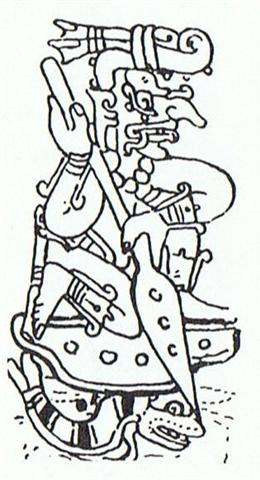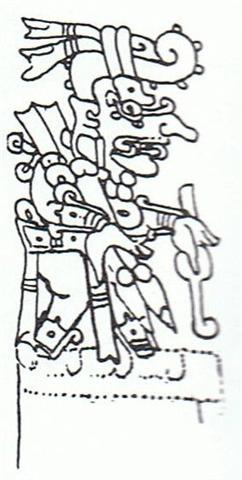1. Beyond Capricornus lies the Sea in the sky and the zodiacal sign of Aquarius. The old year (the Goat) is returning to his homeland in a canoe: ... The fertility of nature thus taken by humanity, a tribute-canoe of offerings to Lono is set adrift for Kahiki, homeland of the gods. The New Year draws to a close ... He was not alone in his canoe but accompanied by all his stations (see at Rogo): ... the first month of the Moriori year, was named Rongo (Lono). On the first of the new year the Moriori launched a small canoe to Rongo, although they built and used only rude craft for their fishing excursions. The canoe was manned by twelve figures symbolizing the personifications of the twelve months. Sometimes twenty-four figures were placed in the canoe, and Skinner interprets the additional twelve as representing the female counterparts of the months. As an old Maori once remarked. 'Everything has its female counterpart.' ... A curious diversion appears in the month list of the people of Porapora and Moorea in the Society Islands, which sheds light on the custom of the Moriori who sometimes placed 24 figures in the canoe which they dispatched seaward to the god Rongo on new years day. The names of the wives of the months are included, indicating that other Polynesians besides the Chatham Islanders personified the months ... Perhaps the first 3 stations in a calendar should tell the story of a Sea-voyage (with Sun like a Fish), followed by a flight through the air (Sun as a Bird), and finally reaching his destination by alighting (on) Mother Earth (like a King):    ... At first the Rain God is moving in a canoe across the waters (high up in the sky), then he is in midair, and then he reaches ground level. After these descending steps Sun climbs upwards again, reaching the top of the 'tree' (climax) at midsummer, followed by a sudden drop not to the ground but into the earth. Even further down there will be water, because water moves downwards and accumulates there ... (See at The Rain God) In his 3rd station the feet of the Rain God are firmly placed upon terra firma. The 3 invisible female feet (with 14 toes) are only perceived by their imprints. But they evidently are oriented 90º away compared to the Rain God feet. This type of 'cosmic perspective' was used also in ancient Egypt, where the great 'game-board' of Land was oriented sideways:
In Egypt, as on Easter Island, the birds of spring are arriving from the north and the fundamental orientation is therefore the same, determining the rest, which explains the many similar traits between Egyptian and Easter Island cosmic ideas. There is a curious expression 'sitting sideways', mentioned in Marshall Sahlins' Islands of History: "... The older sister of god and man, La'ila'i, is the firstborn to all the eras of previous creation. By Hawaiian theory, as firstborn La'ila'i is the legitimate heir to creation; while as woman she is uniquely able to transform divine into human life. The issue in her brothers' struggle to possess her is accordingly cosmological in scope and political in form. Described in certain genealogies as twins, the first two brothers are named simply in the chant as Ki'i, a man and Kane, a god. But since Ki'i means image and Kane means man, everything has already been said: the statuses of god and man are reversed by La'ila'i's actions. She 'sits sideways', meaning she takes a second husband, Ki'i, and her children by the man Ki'i are born before her children by the god Kane ..." The name of the 'old sister' is La'ila'i, which we easily can understand as the negation of Ragi (Sky). In Islands of History there is furthermore related a model for how a new King arriving across the sea should be treated (see at Kava): ... Indeed, at the rituals of the installation, the chief is invested with the 'rule' or 'authority' (lewaa) over the land, but the land itself is not conveyed to him. The soil (qele) is specifically identified with the indigenous 'owners' (i taukei), a bond that cannot be abrogated. Hence the widespread assertion that traditionally (or before the Lands Commission) the chiefly clan was landless, except for what it had received in provisional title from the native owners, i.e., as marriage portion from the original people or by bequest as their sister's son ... The ruling chief has no corner on the means of production. Accordingly, he cannot compel his native subjects to servile tasks, such as providing or cooking his daily food, which are obligations rather of his own household, his own line, or of conquered people (nona tamata ga, qali kaisi sara). Yet even more dramatic conditions are imposed on the sovereignity at the time of the ruler's accession. Hocart observes that the Fijian chief is ritually reborn on this occasion; that is, as a domestic god. If so, someone must have killed him as a dangerous outsider. He is indeed killed by the indigenous people at the very moment of his consecration, by the offering of kava that conveys the land to his authority (lewaa). Grown from the leprous body of a sacrificed child of the native people, the kava the chief drinks poisons him ... Sacred product of the people's agriculture, the installation kava is brought forth in Lau by a representative of the native owners (mataqali Taqalevu), who proceeds to separate the main root in no ordinary way but by the violent thrusts of a sharp implement (probably, in the old time, a spear). Thus killed, the root (child of the land) is then passed to young men (warriors) of royal descent who, under the direction of a priest of the land, prepare and serve the ruler's cup ... the tuu yaqona or cupbearer on this occasion should be a vasu i taukei e loma ni koro, 'sister´s son of the native owners in the center of the village'... Traditionally, remark, the kava root was chewed to make the infusion: The sacrificed child of the people is cannibalized by the young chiefs. The water of the kava, however, has a different symbolic provenance. The classic Cakaudrove kava chant, performed at the Lau installation rites, refers to it as sacred rain water from the heavens ... This male and chiefly water (semen) in the womb of a kava bowl whose feet are called 'breasts' (sucu), and from the front of which, tied to the upper part of an inverted triangle, a sacred cord stretches out toward the chief ...
(pictures from Cecilia Lindqvist's Tecknens Rike showing very old Chinese cooking vessels) The cord is decorated with small white cowries, not only a sign of chieftainship but by name, buli leka, a continuation of the metaphor of birth - buli, 'to form', refers in Fijian procreation theory to the conceptual acception of the male in the body of the woman. The sacrificed child of the people will thus give birth to the chief. But only after the chief, ferocious outside cannibal who consumes the cannibalized victim, has himself been sacrificed by it. For when the ruler drinks the sacred offering, he is in the state of intoxication Fijians call 'dead from' (mateni) or 'dead from kava' (mate ni yaqona), to recover from which is explicitly 'to live' (bula). This accounts for the second cup the chief is alone accorded, the cup of fresh water. The god is immediately revived, brought again to life - in a transformed state ... We can here perceive a similarity with the idea of pushing away the season of hunger (the 'Goat'). She must be killed at the time of renewal. The King has to die before a rebirth (bula = hura, 'life') can come:
|




